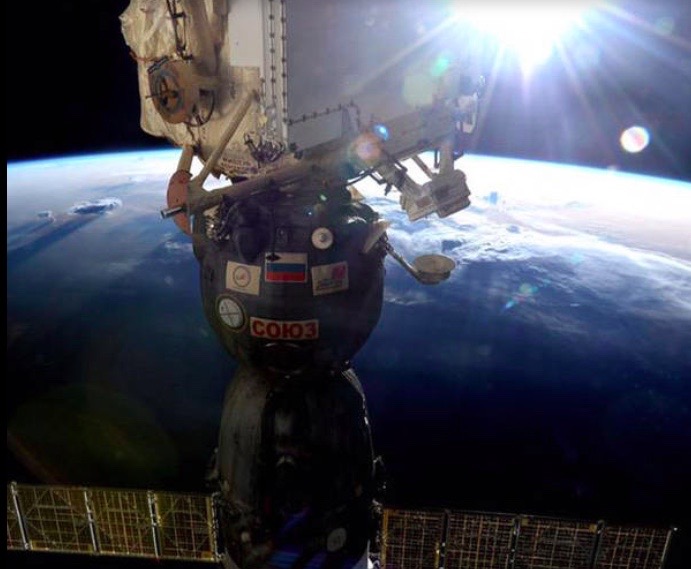

- RUSSIAN SPACECRAFT THRUSTERS INTERNATIONAL SPACE STATION PROFESSIONAL
- RUSSIAN SPACECRAFT THRUSTERS INTERNATIONAL SPACE STATION SERIES
Instrumentation improvements also include a colour ‘glass cockpit,’ which is easier to use and gives the crew more information, with hand controllers that can be secured under an instrument panel. With the new entry control system and three-axis accelerometer increasing landing accuracy. The two new engines reduce landing speed and the force felt by crew members, by 15 to 30 per cent. In addition, the Soyuz TMA accommodates individuals as large as 1.9 metres (6 feet, 3 inches tall) and 95 kilograms (209 pounds), compared to 1.8 metres (6 feet) and 85 kilograms (187 pounds) in the earlier TM. It has smaller and more efficient computers and improved displays. 6Ĭompared to the Soyuz TM, Soyuz TMA has increased safety, especially in descent and landing. Its design incorporated changes to meet certain NASA requirements as an ISS ‘lifeboat’-including eased height and weight restrictions for crew members. The Soyuz TMA debuted in 2002 with a crewed flight to the ISS. The latest variant-Soyuz TMA spacecraft, is a replacement for the Soyuz TM, which was used from 1986 to 2002, to take astronauts and cosmonauts to Mir and then to ISS.
RUSSIAN SPACECRAFT THRUSTERS INTERNATIONAL SPACE STATION SERIES
The Soyuz spacecraft has undergone a series of upgrades since 1967. 4 A look into Soyuz-TMA capsule architecture 5 After leaving the space station, the Soyuz takes about three and a half hours to land. When the Soyuz gets close to the ground, it fires small rocket engines to slow down more, after which it lands in the grassy plains of Kazakhstan. The atmosphere slows the Soyuz and it further uses parachutes to slow down more. To land, the Soyuz drops through Earth's atmosphere. The crew uses the hatch on the Soyuz to enter and leave the station and when the crew is ready to come home, they ride in the Soyuz capsule back to Earth. The Soyuz capsule takes about six hours to get to the space station and at least one Soyuz spacecraft is docked to the ISS, at all times, as an escape craft in the event of an emergency. The rocket returns to Earth, while the capsule goes and docks with the ISS.

Soyuz, the rocket, is the most frequently used launch vehicle in the world (if you ask me, one of the most beautiful rockets in the world fleet), and as of 2021, has made 1900 flights since its debut in 1966.Ī spectacular Soyuz lift-off Image: Courtesy of The European space Agency (ESA)Īfter the launch, the capsule and rocket separate. Soyuz also happens to be a series of spacecraft, which have been flying since their debut, in 1967. Soyuz-the-rocket, and Soyuz-the-spacecraftįor those not familiar with the Soyuz fleet, it perhaps makes sense to clarify that there are two types of Soyuz-the first is a family of expendable Russian and Soviet carrier rockets developed by OKB and manufactured by Progress Rocket Centre in Samara, Russia. Those were super exciting times for a young engineer-designer exploring the world of space, human factors and habitability, among other things. The NASA stint was a dream come true-thrilling and joyous-because two of my favourite human spacecrafts became real, operational, orbital crafts that flew in space missions that I got to work on.
RUSSIAN SPACECRAFT THRUSTERS INTERNATIONAL SPACE STATION PROFESSIONAL
Many years later, after post graduation, in 1997, I went to work on Shuttle-Mir missions, while on a professional placement at NASA's Johnson Space Center. This book marked both my introduction and interest in human space ferries. She had brought this copy with her from the United States, when her husband worked at NASA. My Sanskrit teacher presented me with the book Aboard the Space Shuttle, published in the 1980s, by the NASA headquarters in Washington DC. I grew up reading about them, dreaming about them, drawing them, as well as making scaled models of them while in high school.
jnLGdP.Out of all the human spacecrafts, I am most nostalgic for two human space ferries of my time-the American Space Shuttle and the Russian Soyuz spacecraft. How the ISS could stay in orbit without Russia


 0 kommentar(er)
0 kommentar(er)
